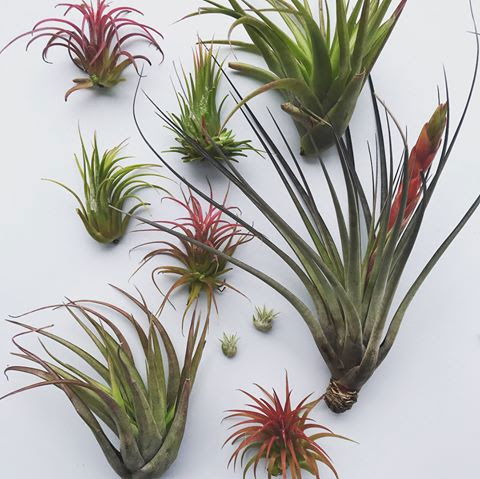
Tillandsia ionantha, T. juncea, T. xerographica & T. seleriana.
Contents
- Top Tips
- Location, Water, Humidity & Fertilisation
- Common Issues
- Origins, Temperature, Propagation & Toxicity.
Need the answer to a specific plant query? Book a 1-to-1 video call with THE HOUSEPLANT DOCTOR™, the website's friendly author, to overcome and address your niggling problem! Available on iMessage, WhatsApp, Facebook Messenger & more.
Top Tips & Info
- Care Difficulty - Easy
- Finely mist the foliage twice a week throughout the year. Try not to saturate the central cubbyholes too often during the autumn and winter as the risk of 'heart rot' is a prominent issue among darkened environments.
- Submerge the whole specimen for around half an hour, every two weeks during the growing period and every three or four weeks in the autumn and winter.
- Shake the plant upside down gently, before placing it on a tissue for a few hours to remove the trapped moisture.
- Provide a bright, indirect setting with good air circulation. Locations that are within three metres of an operating radiator should be avoided at all costs.
- Separate the basal offsets (Pups) during the spring, once they reach half the mother plant's size. Scroll down to 'Propagation' towards the end of this article for more information. Alternatively, keep them together to create an 'Air Plant Cluster' (Google it to see what we mean!).
- These plants are perfect for a simple-themed terrarium or display due to the benefits of a closed environment (i.e. humidity and reliable temperatures).
Location & Light - 🔸🔸
Air Plants are epiphytic and therefore grow in any semi-shaded along the moist nooks of jungle trees. The canopy protects them from several elements, including poor air circulation, water-logging and the direct sunlight. With this in mind, provide a bright, indirect location that offers a good wide-angle of the natural lighting. This could be below a grow light, within two metres of a north-facing window, or in the canopy of another plant (near to a light source). We have a four-foot Bonsai (Ficus retusa) that has several Air Plants resting within its branches, and this works exceptionally well for both parties. As the tree is rather tall with an airy centre, it provides a good blend of air circulation and along with the protection from possible direct light. We would highly recommend keeping your rootless friends in another plant due to the reduced risk of 'heart rot' that's prominent with surface-resting specimens.
One final tip is to provide an hour of autumn and winter sunlight through the dormancy period. As the days are at their shortest, the natural lighting won't have the effect of drying its centre out from recent irrigation, meaning that it'll stay too moist for longer. Relocate the specimen once the spring returns to avoid sun-scorch and dehydration.
Water - 🔸🔸
There are several key ingredients to successfully hydrating an Air Plant without the risk of over-watering. The frequency in which you'll need to mist and submerge the specimen will solely rely on the light levels and the current season that you're serving. Choose from one of the following watering techniques to follow each week;
1. Once a fortnight (monthly in autumn & winter), give the plant a thorough dunk in lukewarm water for around an hour. Lightly shake the foliage (upside down) and place on a dry cloth or tissue for the absorption of excess moisture. Rest the specimen upside down, so that its base is facing the window to improve air circulation around its basal plate. Relocate back into its original location once fully dry.
N. B. - Irrigations must never occur at night, as the combination of longer drying-out times and low-light will significantly increase the chance of death.
2. Finely spray the foliage twice a week using lukewarm water. Although a thorough saturation must be avoided for reasons mentioned above, be sure to give it enough water for sufficient hydration until the following mist. If misting isn't for you, dunk the leaf-tips in water for a few seconds before a gentle shake-down. The moisture will travel along the leaf and into the centre without causing the infamous 'heart rot'. Scroll down for an image of this.
3. If you're a little forgetful with the mists and submersions, introduce a pebble/humidity tray by filling a saucer of stones with a shallow reservoir of water. Situate the Air Plant onto the bed of stones, topping the water once it almost runs out. Be sure not to let the plant's base touch the water as this will result in rot. If the tray is used, reduce the recommended mists to only once a week, due to the higher humidity and longer drying-out times.
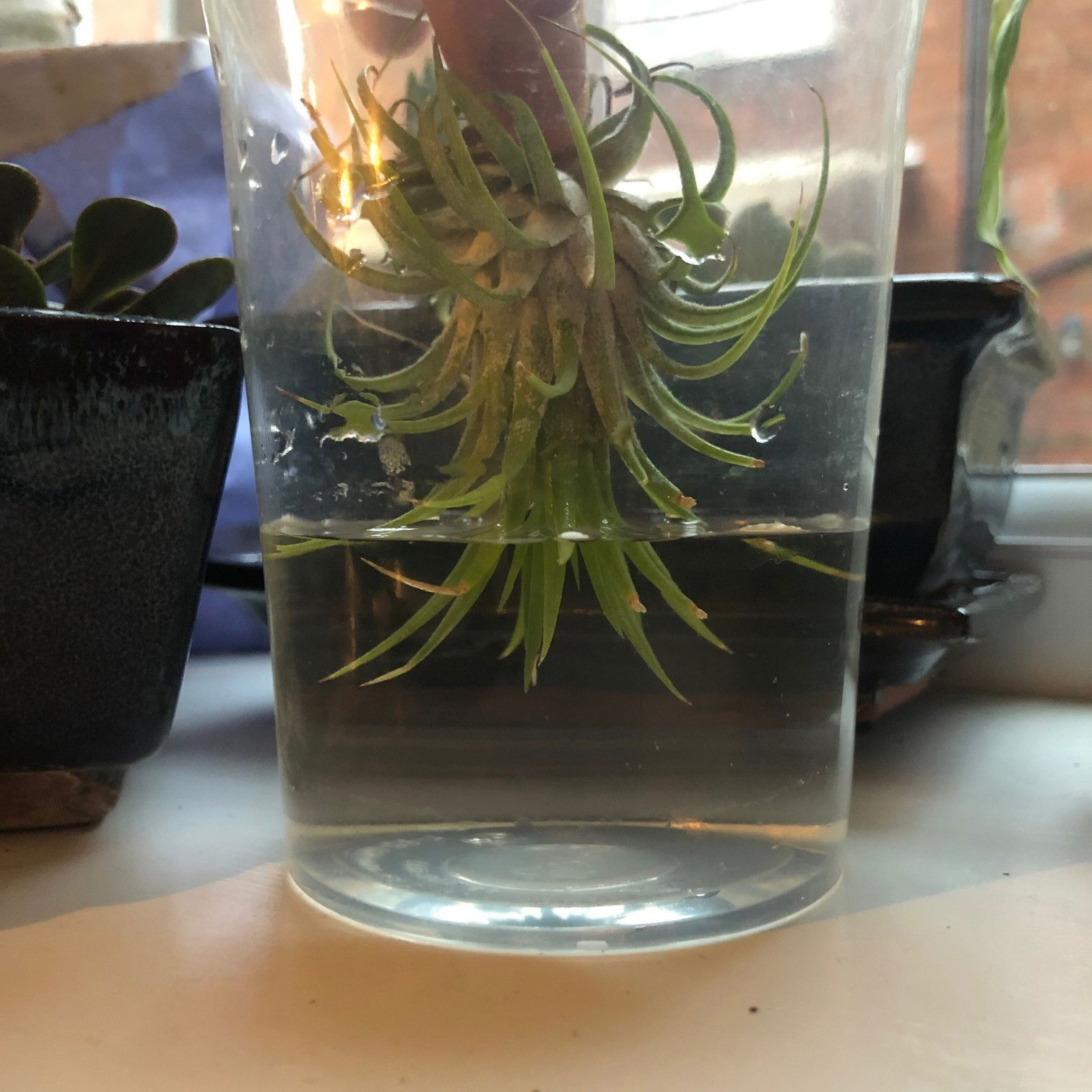 A quick leaf-tip dip is an appropriate alternative to misting.
A quick leaf-tip dip is an appropriate alternative to misting.
Fertilisation - 🔸🔸
Monthly supplements using either 'Bromeliad' or 'Orchid' feed (both at half strength) is best to provide the vital nutrients for an Air Plant. Go against using a houseplant-labelled fertiliser on this one due to the heightened risk of foliar-burns. Pour half the recommended strength into a non-metal container of water when its time for hydration. There are also 'Air Plant Mists' that will do the job, too; mist the foliage weekly on top of the other hydration-mists to provide the correct nutrients that the plant requires!
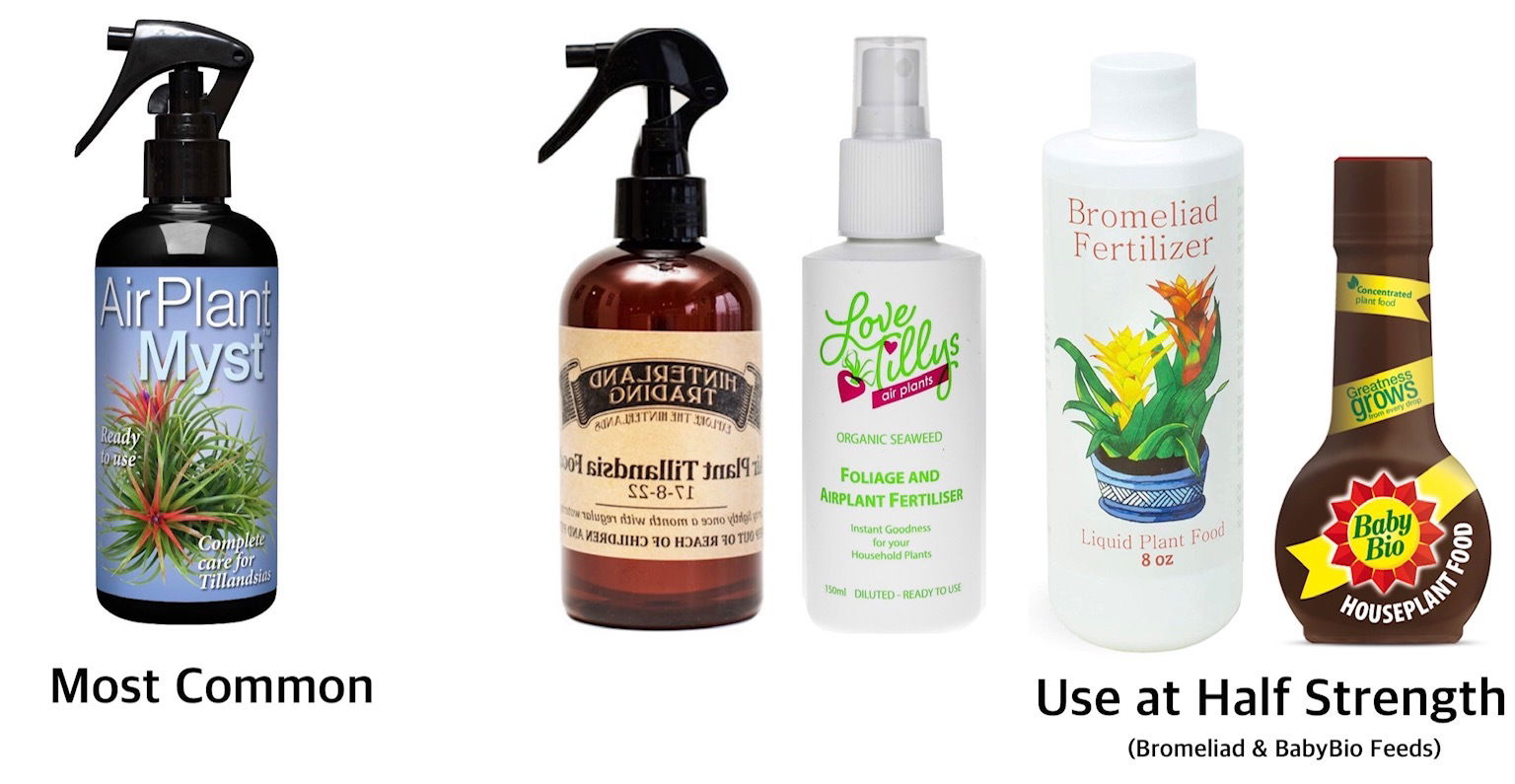 Our recommended feeds for Air Plants.
Our recommended feeds for Air Plants.
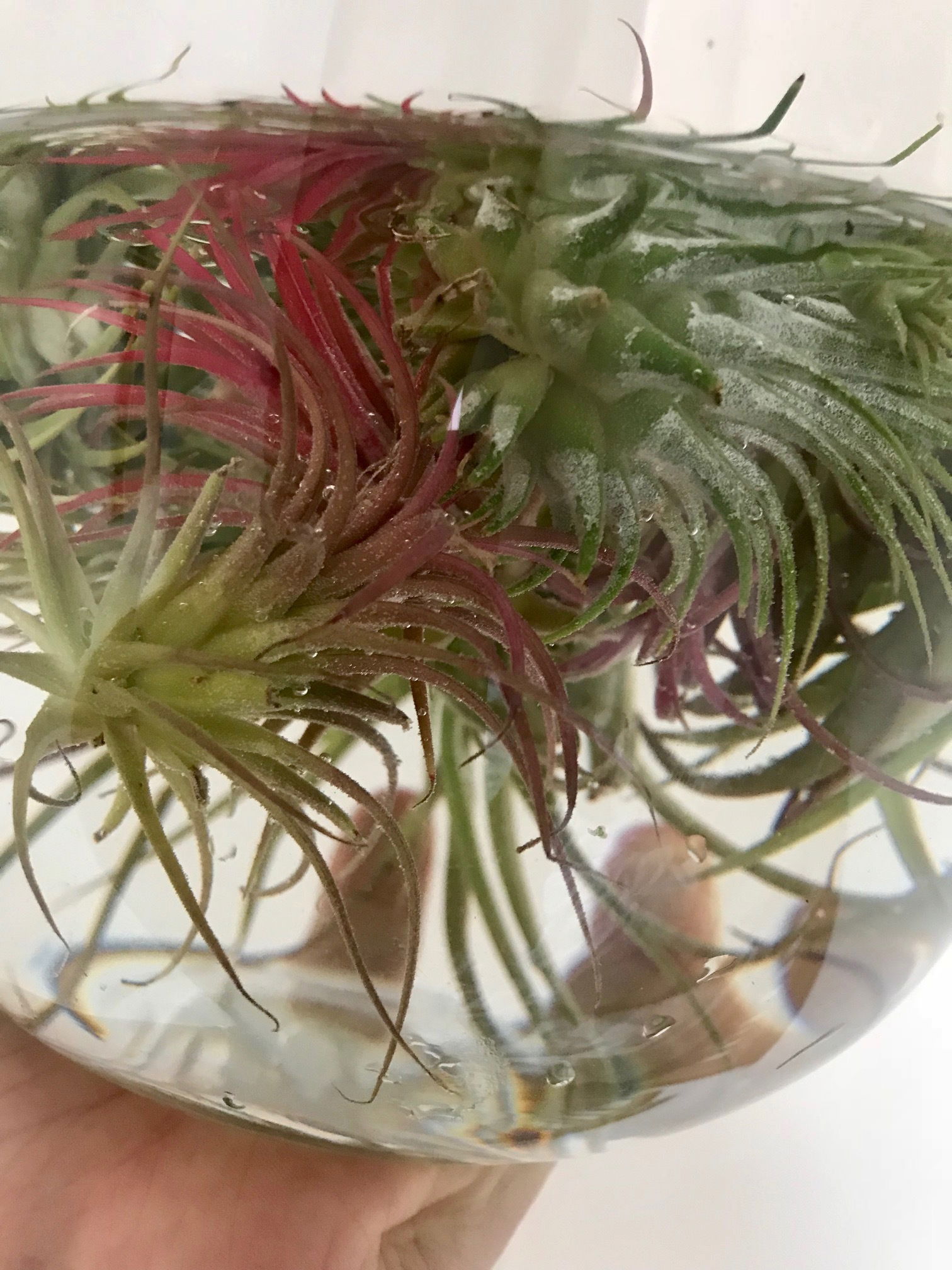 The submersion of Air Plants is great for thorough hydration.
The submersion of Air Plants is great for thorough hydration.
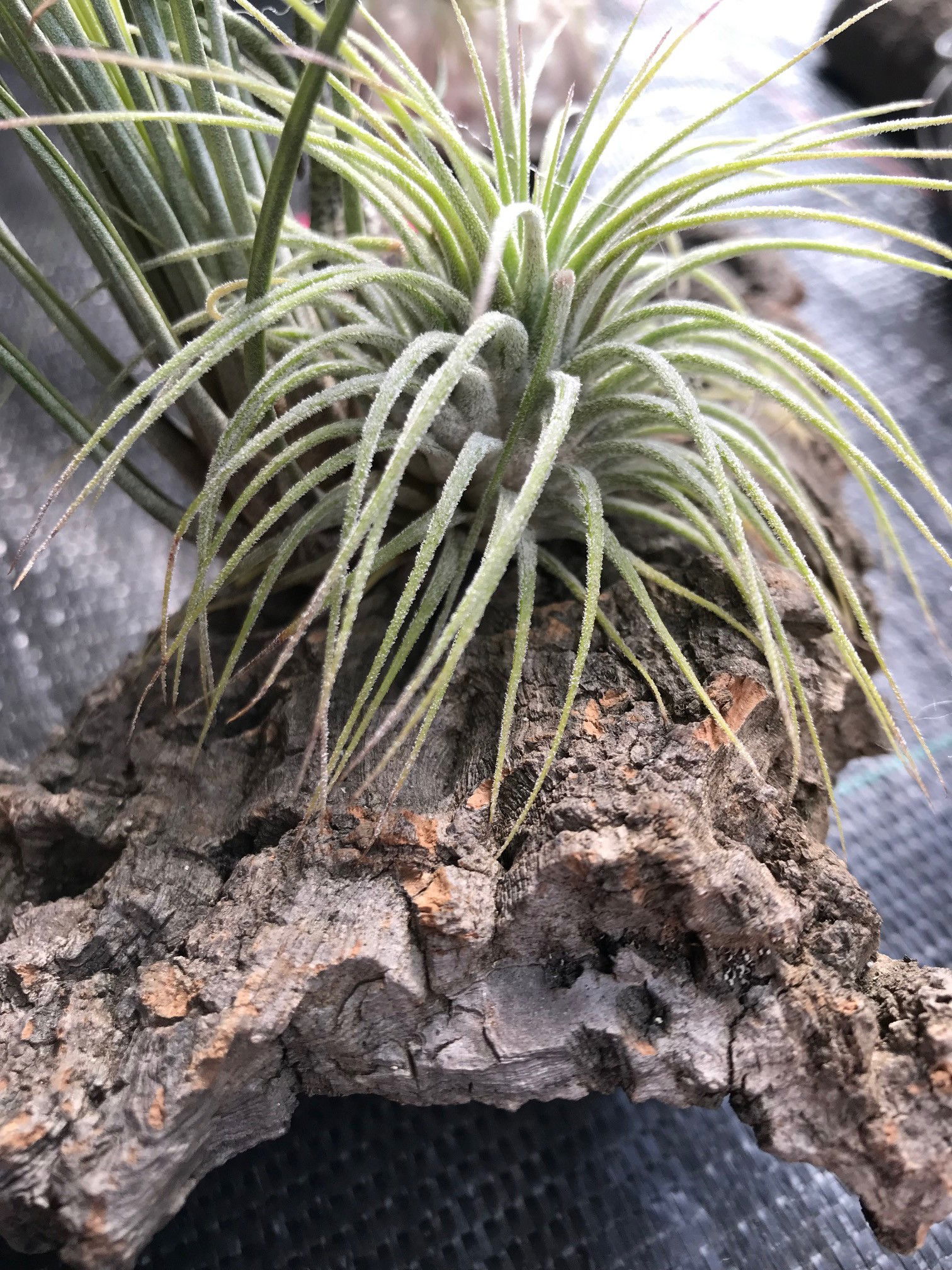 Why not mount your Air Plants on sand-blasted rosewood? These blocks vary in size and can be found at most aquarium or pet stores. Just be careful with excess moisture resting in the specimen's base...
Why not mount your Air Plants on sand-blasted rosewood? These blocks vary in size and can be found at most aquarium or pet stores. Just be careful with excess moisture resting in the specimen's base...
Common Issues with Air Plants
How Do I Tell If My Air Plant Is Dead? To know the overall health of your plant, make sure to submerge it in water for around ten minutes before taking it back out. If the very centre of the Air Plant has become brown with no green areas (on any of the leaves), this means the plant has sadly died. There is nothing that can be done to save this plant as its centre is the only point of growth, where new leaves or 'pup's would develop. Only green Air Plants (after being submerged in water) are still alive.
Brown tips symbolise possible under-watering, or the surrounding humidity is not high enough. During the colder months, heaters will be on full steam ahead, meaning that dry air will be at its highest. Keep an eye out for the development of browning tips on the juvenile growth.
Curled murky-yellow leaves and brown leaf-tips are the result of too little water and/or over-exposure to the sun. Air Plants are best located in bright, indirect settings, and those that haven't acclimatised to the harsh rays will show signs of sun-scorch and environmental shock. A splash of winter sunlight is acceptable as long as the surrounding moisture is regularly observed, with complete avoidance once the spring and summer comes along.
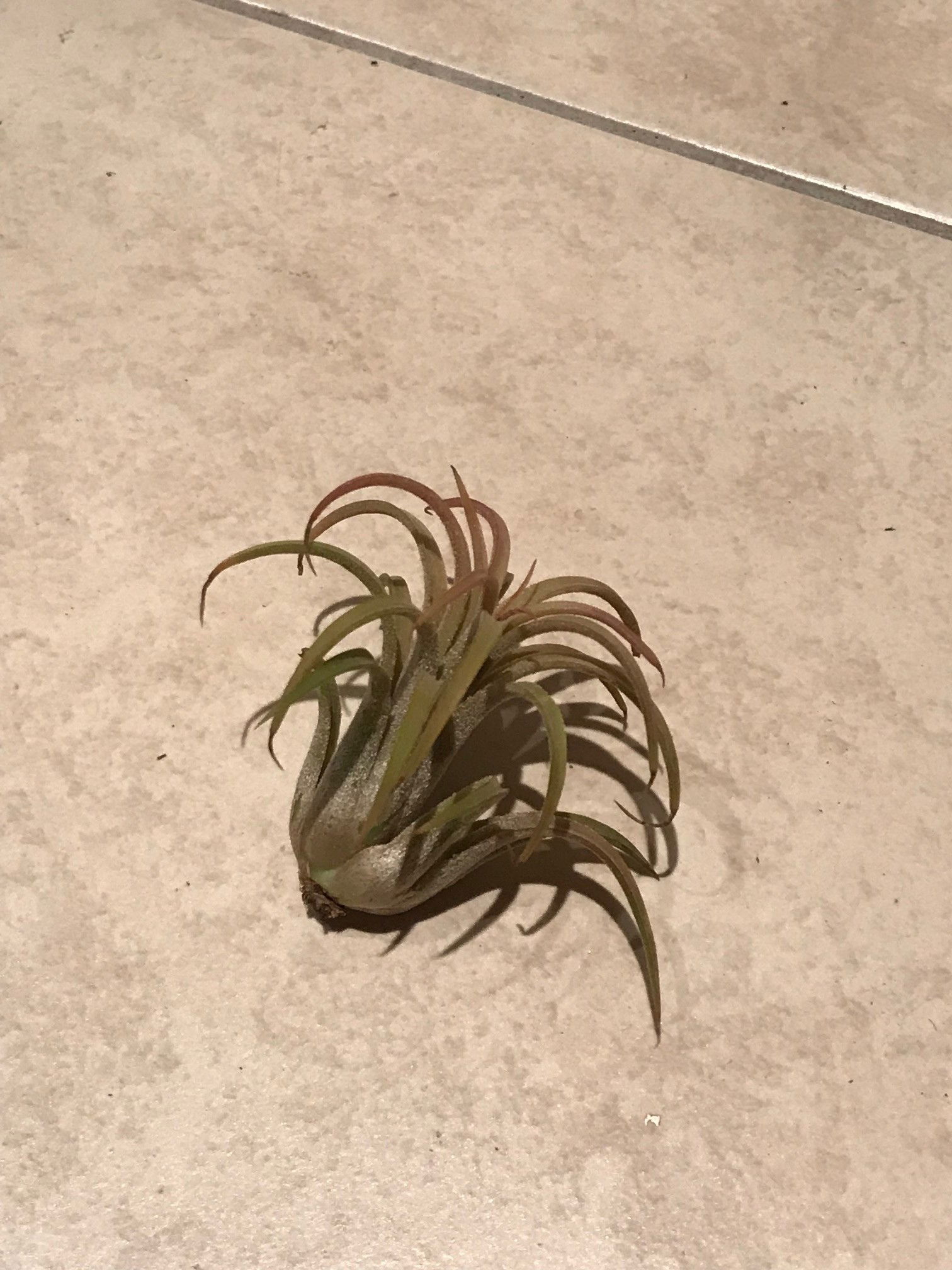 Greying or yellowing of leaves is a clear product of persistent under-watering Tillandsia ionantha
Greying or yellowing of leaves is a clear product of persistent under-watering Tillandsia ionantha
Over-watering is a serious issue among owners, with signs of a rotting core not screaming out until the plant is submerged again. At this point, the plant sport a brown mushy base and will collapse shortly afterwards. Although this usually spells the end, if only a few leaves have browned over at the joint, it may still survive if the affected areas are removed. The risk of over-watering and 'heart rot' are heavily associated with dark or poor air circulated environments.
The decolorisation of leaves is normal. Shortly after the flowering period, its neon red or purple colours will begin to fade back to green, signalling the end of the blooming process. Alternatively, if the plant starts to change colour from green, it means flowers are potentially on the way!
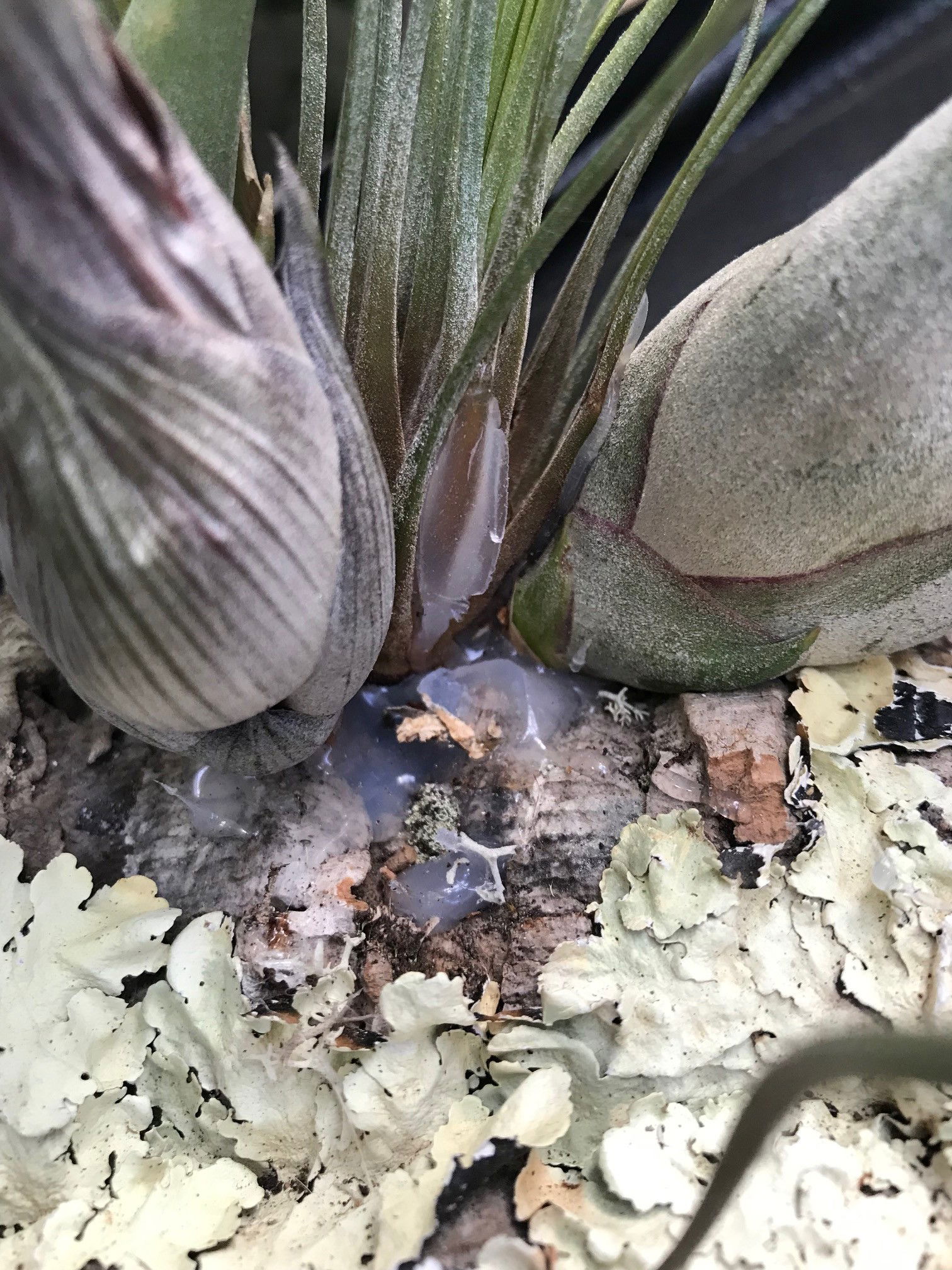 Either sit or glue the Air Plants onto the wood; the Plant Fixative Glue are mostly sold online.
Either sit or glue the Air Plants onto the wood; the Plant Fixative Glue are mostly sold online.
Origins
Although Tillandsia is mostly epiphytic, there are fifteen species that grow terrestrially and therefore require different care compared to their airborne counterparts. The genus was first penned in 1753 by Carl Linnaeus, honouring Dr E. Tillandz, a Swedish botanist and physician during mid-17th-century. Out of the 650 species of Tillandsia, around 630 are classified as epiphytic and are divided into seven subgenera - Allardtia, Anoplophytum, Diaphoranthema, Phytarrhiza, Pseudalcantarea, Pseudo-Catopsis & Tillandsia.
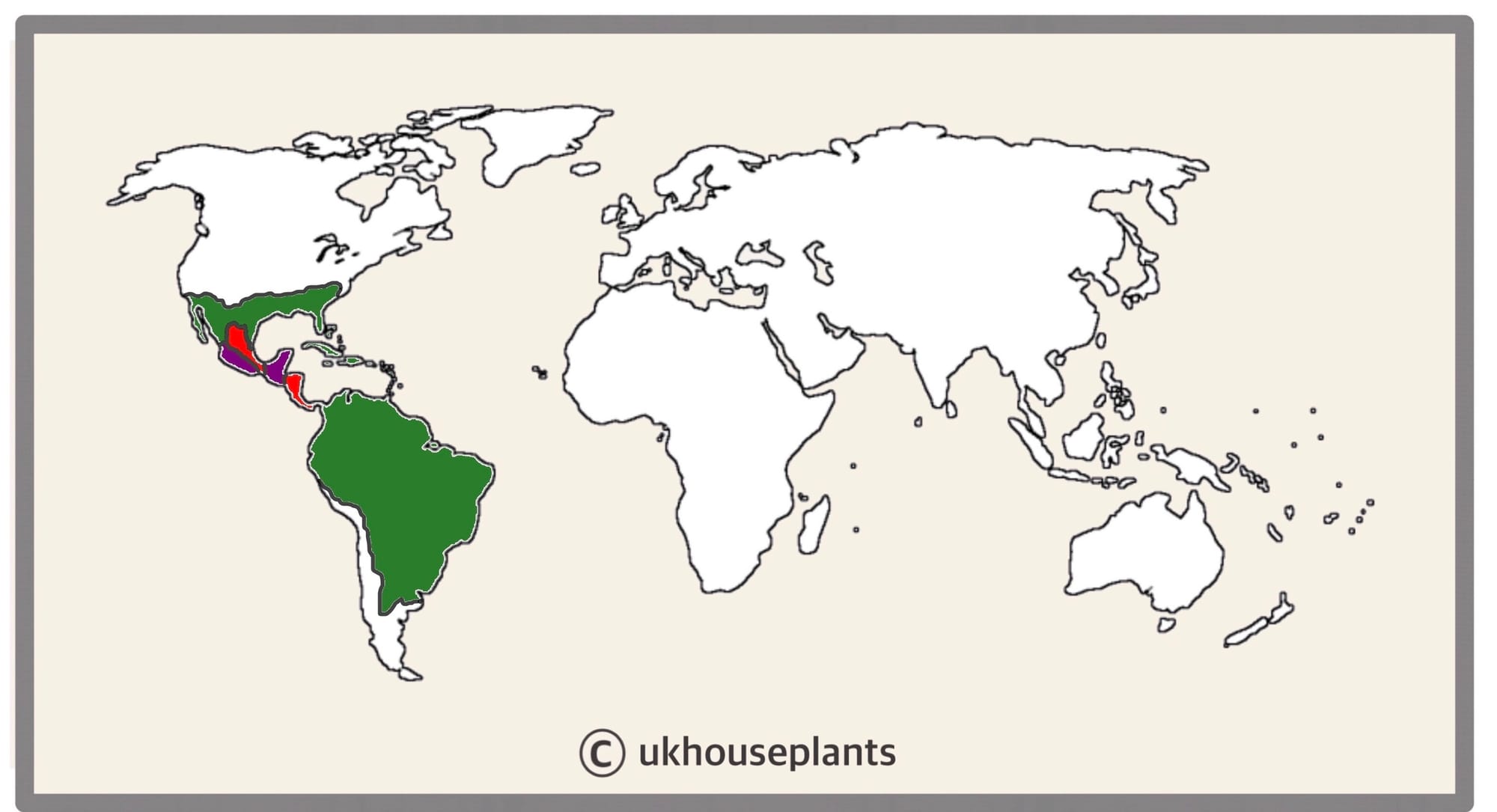 The Distribution of Tillandsia in Green, T. ionantha in Red, and T. ionantha & T. xerographica in Purple.
The Distribution of Tillandsia in Green, T. ionantha in Red, and T. ionantha & T. xerographica in Purple.
Temperature
12° - 30°C (54° - 86°F)
H1b (Hardiness Zone 12) - Can be grown outdoors during the summer in a sheltered location with temperatures above 12℃ (54℉), but is recommended to stay indoors. If you decide to bring this plant outdoors, don't allow it to endure any direct sunlight as it may result in sun-scorch and dehydration. Regularly keep an eye out for pests, especially when re-introducing it back indoors.
Spread
Depending on the variety, smaller specimens like T. argentina, T. ionantha, T. medusa & T. velutina can grow up to 10cm in height and width, whereas bigger specimens like T. xerographica can grow up to 40cm in width and height. To increase the size of an Air Plant, allow the pups (lateral growths) to reach maturity instead of propagation - after a few years, they will form into a cluster or ball, flowering at different times depending on their maturity and size!
Pruning & Maintenance
Remove the spent flowers to improve the overall appearance, eventually pruning the whole bract once it fully elapses over. It's not advised to remove brown basal leaves as this can affect its stability and strength. When removing dying flowers or leaves, use clean scissors or shears to reduce the chance of bacterial and fungal diseases.
Propagation
Via Seed or Basal Offset Division
Basal Offsets (Easy When Performed With Respect) - Although most 'pups' will develop once the flowers begin to die, some will form at any given time of the year. Once they surpass 3cm (1.1 inches) in height or at least half the mother plant's size, they can be safely removed by twisting at the joint. Its care requirements will be mostly similar to its original life; however, be sure to water it slightly more frequently than its parent for dehydration reasons. Never propagate a pup that's smaller than one and a half baked beans, as the lack of stored energy will ultimately lead to death.
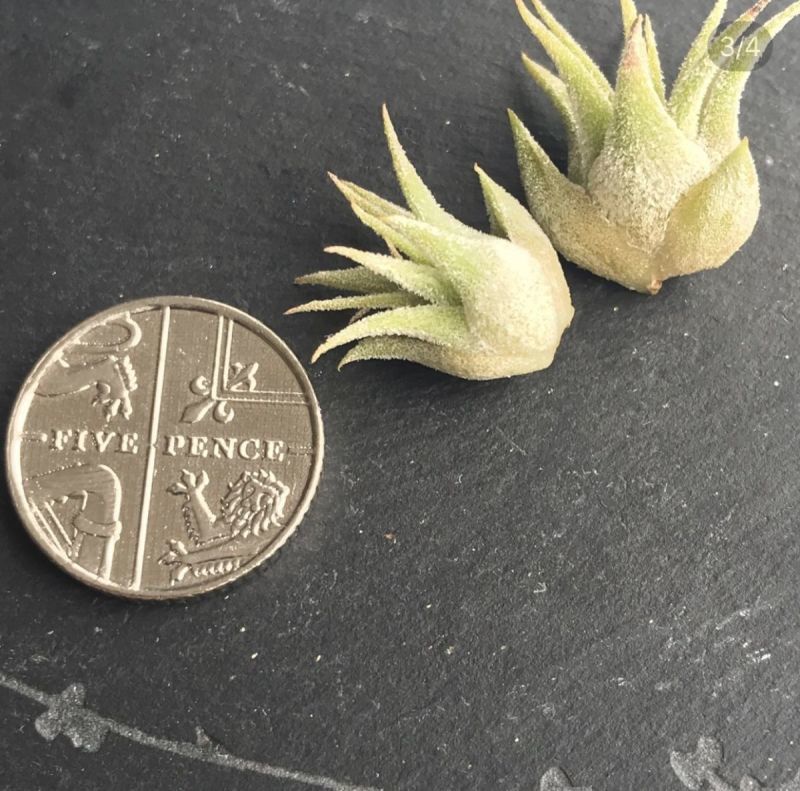
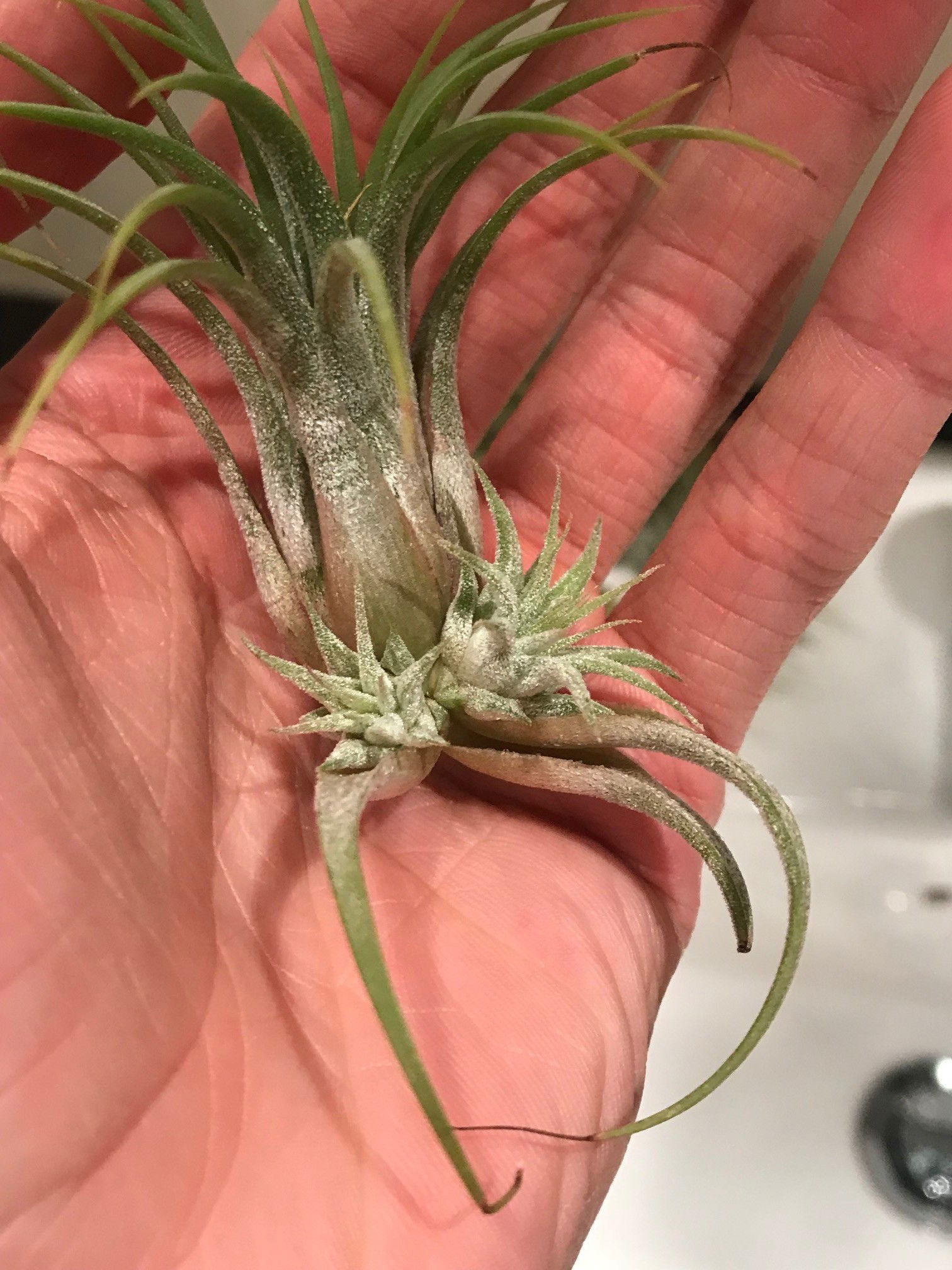 Two small 'pups' that are still too small to individually separate.
Two small 'pups' that are still too small to individually separate.
Flowers
An individual Air Plant will only flower once, lasting around a week. The bract's colour varies between purple, yellow, pink and red, which helps attract airborne pollinators such as insects, hummingbirds and small bats. The colour variations can also occur on the Air Plants' foliage during its blooming season, usually a red or purple tinge.
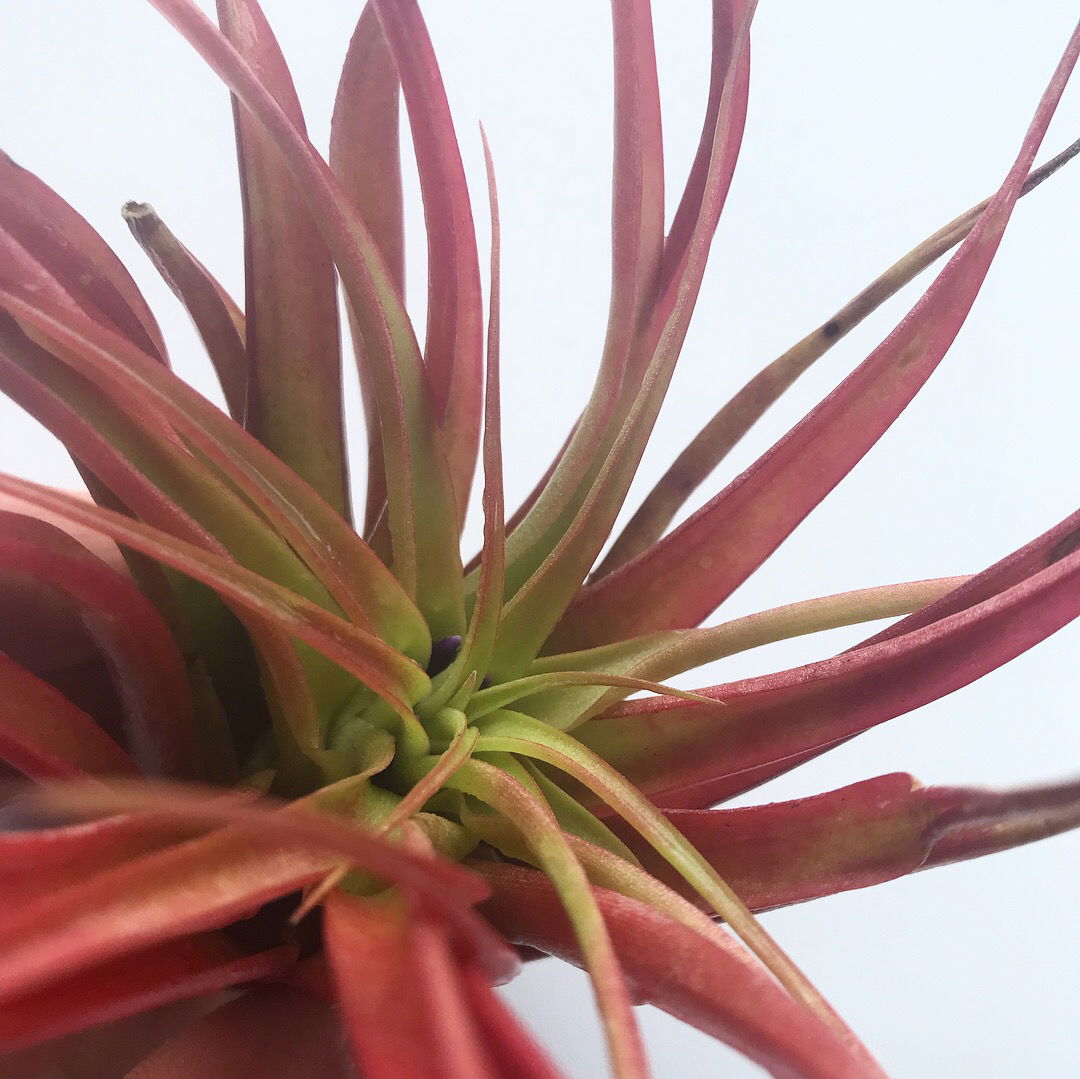 Most Air Plants will change their foliage colour to attract airborne pollinators during the flowering process.
Most Air Plants will change their foliage colour to attract airborne pollinators during the flowering process.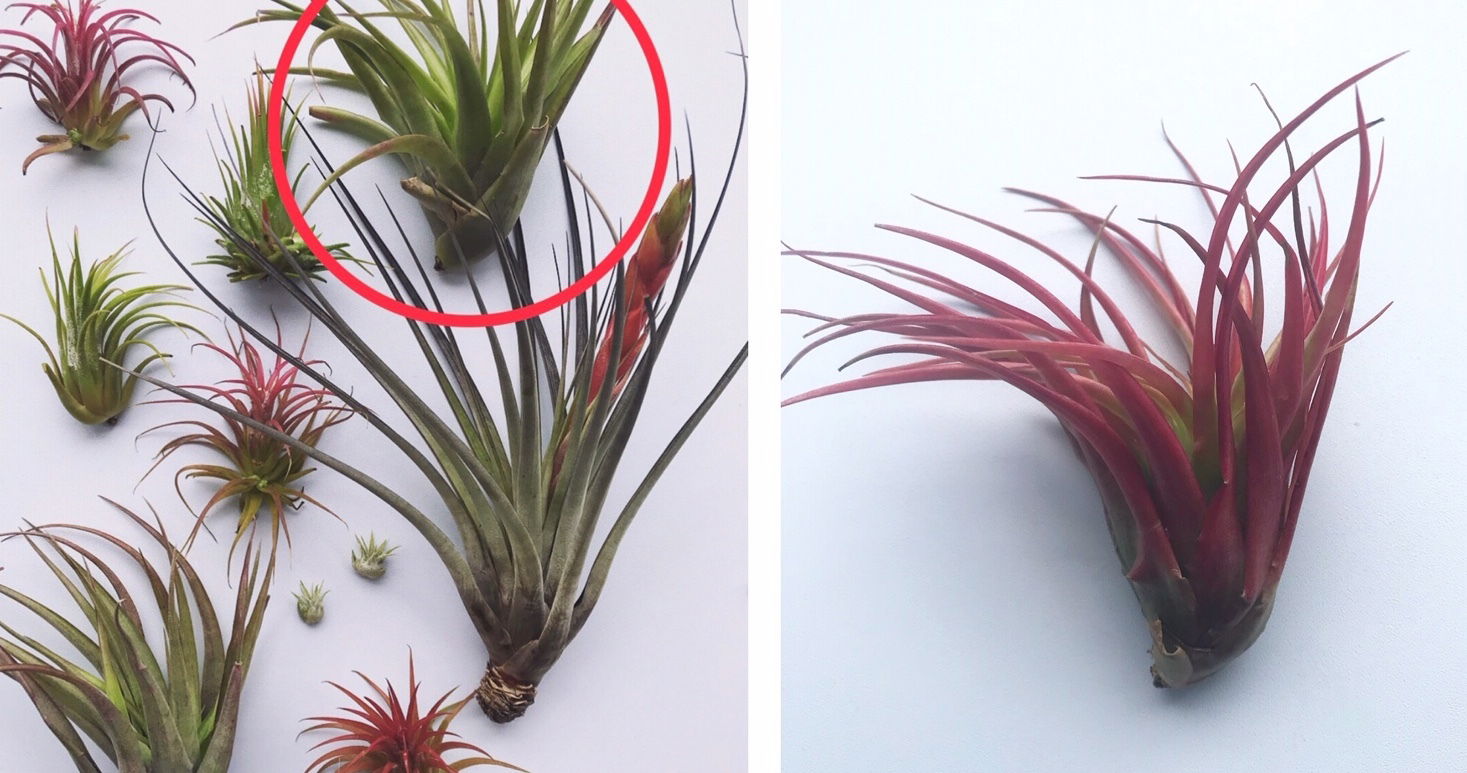 Two photos, taken just three weeks apart.
Two photos, taken just three weeks apart.
Pests & Diseases
It's very rare to find any pests. Crown or 'heart rot' could occur if kept too moist, commonly accompanied by a too dark of a location; scroll up to 'Common Issues' for further advice on the matter.
Toxicity
Not known to be poisonous when consumed by pets and humans. If large quantities are eaten, it may result in vomiting, nausea and a loss of appetite.
Retail Locations
Blue Diamond, Dobbies, Online Stores.
Book a 1-to-1 Call with THE HOUSEPLANT DOCTOR™
If you need further advice with your houseplants, book an advice call with ukhouseplants' friendly and expert writer today! This can be done via a video or audio call on most apps, including Facebook, FaceTime & Skype. A ten-minute call costs £5.99 (US$7), or £15.99 for thirty minutes. You can ask multiple questions, including queries on plants, pests, terrariums, repotting advice and anything in between. Please consider supporting this service to keep ukhouseplants thriving!